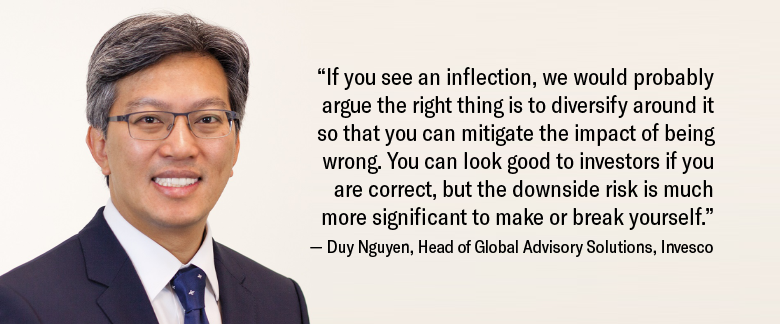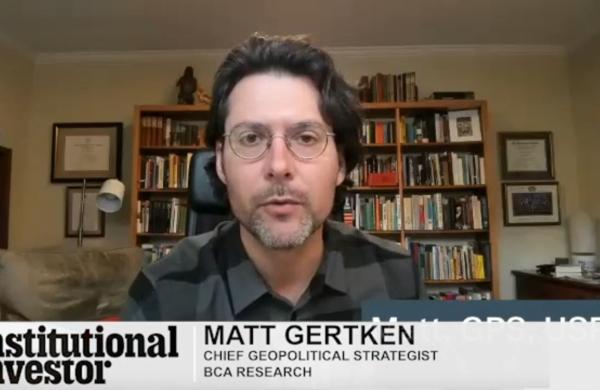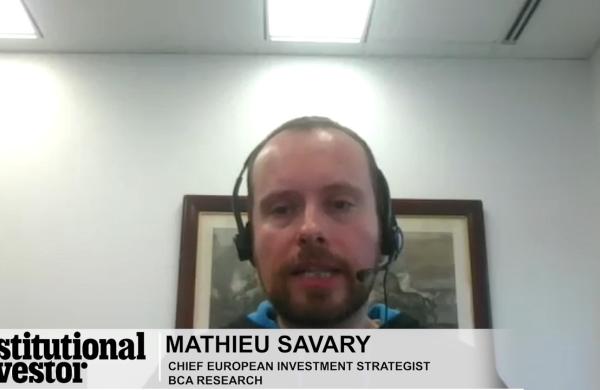Asset managers can make assumptions about capital market regimes in terms of economic policy. On a basic level, one can break down the business cycle into quadrants or a four-phase matrix: economic contraction versus expansion, and high or low inflation regimes. “You can bifurcate regimes in a number of ways, and they don’t have to be mutually exclusive,” says Duy Nguyen, Head of Global Advisory Solutions at Invesco. “But this perspective allows those who are managing money to think about what will happen in the future, and how that behavior has manifested in the past.”

Risk awareness adds a further element. For instance, when you break out oil price history under various regimes, what are the implications of rising or falling energy costs? Another consideration would be the return expectations of a given asset according to its underlying fundamental drivers. It is feasible to perform that exercise from either a bottom up or a top down perspective. “Doing so allows us to understand what is moving the expectations of asset classes from quarter to quarter, or from year to year,” Nguyen says.
Of course, all these assumptions must be developed in a specified time framework. Invesco’s Investment Solutions team generally establishes an outlook on a traditional 10-year forward-looking basis, to incorporate an entire business cycle. Occasionally, investors with very long-duration assets, like insurance companies, may prefer a 30-year forecast. This is also something that Invesco Investment Solutions provides. Harmonizing investment strategies with investment horizons is essential when attempting to deliver investment outcomes.
An appropriate time horizon must reflect a client’s individual circumstances and liabilities, such as funding status. Underfunded asset owners may not have the luxury of waiting for risky assets to pay themselves off, and some may face cash drawdowns. “So, there are other parameters to take into consideration—your funding level, where you are cyclically in the marketplace, your investment goals, are all other important aspects,” says Nguyen.
Where are we here and now?
Regimes within economic cycles tend to be sticky, which gives a decent spate of time to prepare for inevitable changes in the environment.
Invesco’s current models still favor a continuing expansionary environment, with low inflation, conducive to economic growth. Looking ahead, though, some signals suggest a contraction over the coming quarters – a slowdown rather than a recession.1
Nguyen mentions a “hint” of elevated inflation: “The labor market is starting to look a little bit tight. We haven’t really seen upward pressure on wages, but I believe we’re at a point where a significant or even marginal increase in the tightness in the labor market should eventually drive some wage pressure.”
The glass may be half empty right now from a capital market viewpoint. Planning for a 5-year outlook essentially encompasses half of a 10-year economic cycle. Since the present 5-year outlook for return expectations is lower than the 10-year prospect, the next half of this economic cycle will likely provide fewer payoffs for risky assets. Most risky assets have already been bid up significantly, and are now priced above their long-term averages, or their fair value. In consequence, any boost from expected returns appears less promising. Nguyen summarizes: “The overwhelming impact of higher valuations has really driven our return expectations lower over time – even though that has abated of late given the recent market pullback.”
That said, income yield still seems reasonable, although inflation expectations must be factored into forward-looking growth. Investors have been expressing concern about inflation, especially pension managers, whose liabilities may be linked to it. Many face additional challenges when inflation levels rise above 3%. Proactively, Invesco has conducted in-depth studies on asset class behavior across various inflation-driven regimes, and has devised customized approaches for multi-asset portfolios during inflationary periods.
And where are global markets in this snapshot? Because returns in non-U.S. and emerging markets have hitherto lagged, valuations may now be positioned to enjoy some catch up room. Meanwhile, high yield rates have been more compressed in the U.S. than in Europe, and may linger there a year or two, before reverting to a more normal range.
Navigating the cycle
The raft of available economic indicators reveals a late stage, ongoing expansion in this cycle. From that position, managers must decide whether they are investing “through” or “along” their investment horizon. It is not easy, however, to contextualize where financial conditions stand. Eventually, macroeconomic indicators, which tend to lag the market, become explicit. What’s difficult, Nguyen warns, is that “most of the downdraft and updraft volatility happens in a very short period.”
Suppose markets look poised for an inflection; it may be dangerous to try to time that pivot. An alternative course is to position for a probability of success. Nguyen advocates this more incremental process. He explains that, “if you see an inflection, we would probably argue the right thing is to diversify around it so that you can mitigate the impact of being wrong. You can look good to investors if you are correct, but the downside risk is much more significant to make or break yourself.” Invesco can help to steer investors through shifting tides, by delivering a more diversified option, rather than one major opportunistic gamble.
True, there are usually indicators to map where we are in the cycle, but by the time these dynamic signposts fully stabilize, we’re observing a post mortem. Invesco suggests a methodology for reacting incrementally to the changing landscape. For example, it may make sense to eliminate the least likely outcome of the four regimes, and then diversify across the remaining three. There will always be trade-offs. The order of magnitude in the change may be too marginal to justify the transaction costs involved, or may be subject to estimation errors.
A deliberate investment strategy calls for optimal positioning, by carefully considering how you want to manage market turning points. Big bets might try to pinpoint the change itself, with a market call. But there is a more nuanced solution: a finely-tuned tilt takes gradual shifts to navigate a wider range of outcomes.
1 As of February 1, 2019
Start the conversation to better outcomes. Learn more.
Additional resources:
Long-Term Capital Market Assumptions
Capital Market Assumptions Q1 2019
Disclosures:
All content provided by Invesco is for informational purposes only and is not an offer to buy or sell any financial instruments.
The opinions expressed are those of the author, are based on current market conditions and are subject to change without notice. These opinions may differ from those of other Invesco investment professionals.
Diversification does not guarantee a profit or eliminate the risk of loss.
Regimes are generally segmented using a mix of qualitative observation and quantitative data and as such are subject to analyst interpretation.
Invesco Advisers Inc. is an investment adviser; it provides investment advisory services to individual and institutional clients and does not sell securities.





